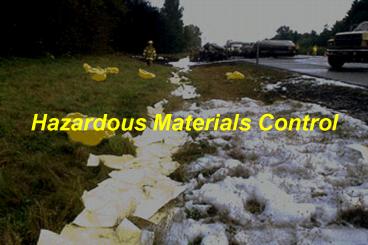Hazardous Materials Control - PowerPoint PPT Presentation
1 / 37
Title: Hazardous Materials Control
1
Hazardous Materials Control
2
Where are we?
- 1 Introduction
- 2 Awareness Review
- 3 Surveying the HazMat Incident
- 4 Hazard Risk Assessment
- 5 Intro to Incident Command
- 6 Protective Clothing Equipment
- 7 Hazardous Materials Control
- 8 Decontamination
- 9 Termination Procedures
- 10 Safety
- 11 Conclusion
3
Hazardous Materials ControlPurpose
- Emergency responders must know how to use
techniques to minimize or prevent harm to life,
environment, or property
4
Hazardous Materials ControlOutcome Considerations
- How to handle spills properly
- Where spills can occur
- Inappropriate control measures
5
Hazardous Materials ControlOverview
- A. Goals Objectives of Spill Control
- B. Steps in Spill/Leak Response
- C. Control Methods
- 1. Containment
- 2. Confinement
6
The Goal of Hazardous Materials Control
- To prevent or minimize environmental damage
7
- The goal of preventing environmental damage is
second only to saving lives
8
Control Objectives
- To prevent the (further) release of a hazardous
material - To restrict the spread of a hazardous material
that has already been released
9
Steps in Spill or Leak Response
- 1. Identify the material and its associated
hazards - 2. Use proper protective clothing and equipment
- 3. Stop the flow at the source (containment)
- 4. Confine spilled material to the immediate area
(confinement) - 5. Recover spilled material (utilizing a
professional clean-up company)
10
Control Methods
Offensive Technician Level
Defensive Operations Level
- Containment Control the flow at the source
11
Defensive Control Operations Level
- Containment Stopping the flow at the source
without approaching the actual point of the
release e.g., defensive closing of valves
12
Offensive Control Technician Level
- Containment Stopping the flow by approach-ing
the point of the release to plug, patch, or
otherwise stop the release (offensive)
13
Legal Considerations
- OSHA First Responder Operations those who
respond in a defensive fashion without actually
trying to stop the release
14
Legal Considerations
- OSHA HazMat Technician those who respond in
order to plug, patch, or otherwise stop the
release
15
Control Methods
- Confinement Confine already spilled material to
the immediate area
16
Solids
Control Methods Confinement
- Containerizing
- Covering
17
Containerizing Placing spilled solid material
into a compatible container
18
Covering Placing a compatible cover over
spilled material to prevent vapor or particle
movement due to wind or exposure to moisture
(rain)
19
Liquids
Control Methods Confinement
- Retaining
- Diking
- Absorption
- Dams
- Remote valve shutoff
- Covering
20
Retaining Catch a liquid spilling or leaking
from an elevated source
21
Diking Stop, slow, redirect flowing liquid
Soil
Booms
22
Diking Protect storm drains
Primary Booms
Secondary Pads
23
Absorption
- Sorbent materials include
- sand diatomaceous earth
- soil sawdust
- vermiculite absorbent clay
- imbibing materials (mats, pads, pillows, beads,
etc)
Sorbent must be compatible with chemical !!
24
Absorption Collecting spilled liquids
25
Dams a barrier built to stop flowing water or
material
- Simple dam
- Complex dam
- - overflow dam
- - underflow dam
26
Simple Dam
water (or contaminant)
dam
Direction of flow
27
Complex (overflow) Dam
water
dam
heavier-than-water contaminant
Direction of flow
28
Complex (underflow) Dam
Direction of flow
lighter-than-water contaminant
water
dam
29
Remote valve shut-off Stopping the flow of
materials at a distance
30
Covering Minimizing vaporization
31
Liquids Dilution
Control Methods
- Positive aspects
- Negative aspects
32
Gases vapors
Control Methods
- Closing doors windows
- Dispersion
33
Review Goals Objectives
The Goal of Hazardous Materials Control
- To prevent or minimize environmental damage
34
Review Steps in Spill or Leak Response
- 1. Identify the material and its associated
hazards - 2. Use proper protective clothing and equipment
- 3. Stop the flow at the source (containment)
- 4. Confine spilled material to the immediate area
(confinement) - 5. Recover spilled material (utilizing a
professional clean-up company)
35
Review Control Methods
- 1. Containment
- 2. Confinement
36
Summary
37
Application Step































